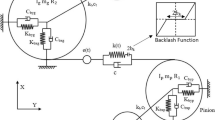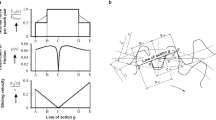Abstract
The formation of rabbit ears during the gear rolling process, caused by the generating motion between the gear roller and the blank, is a common and undesirable phenomenon encountered in gear rolling. It generally leads to fold defects, waste of material, and decline in mechanical properties after removal, seriously affecting the quality of the gear to be formed. In this paper, a finite element model of gear rolling is first established, the gear rolling process are simulated, and the rabbit ear formation mechanism and its morphology change are studied. The phenomenon and the morphology of the rabbit ear are then verified experimentally. The formation mechanism of the rabbit ear was analyzed by means of the stress state, the deformation distribution, and the material flow. The results show the following: (1) the continuous localized contact between the gear roller and the blank induces the material on the surface area of the tooth sequential plastic deformation, while at the same time, the material is squeezed by the tooth flank of the gear roller and flows towards the direction of the smaller resistance, that is, the flank of the tooth. The difference in the material flow velocity between the flank of the tooth and the center of the tooth leads to the formation of the rabbit ear; (2) the asymmetric shape of the ears appears to be related to the different direction of friction exerted on two sides of the tooth depending on the rotational direction of the gear roller. These findings provide a scientific basis to further explore measures to control the rabbit ear defect and improve the forming quality in gear rolling.
Similar content being viewed by others
References
Kondo K, Ohga K (1995) Precision cold die forging of a ring gear by divided flow method. International Journal of Machine Tools & Manufacture 35:1105–1113
Choi JC, Choi Y (1999) Precision forging of spur gears with inside relief. Int J Mach Tools Manuf 39:1575–1588
Hu CL, Liu QK, Zhao Z, Chen J, Wu GM (2010) Two step forging process of spur gear based on rigid parallel motion. Journal of Shanghai Jiaotong University(Science) 15:241–244
Jung SY, Kang MC, Kim C, Kim CH, Chang YJ, Han SM (2009) A study on the extrusion by a two-step process for manufacturing helical gear. Int J Adv Manuf Technol 41:684–693
Li J, Wang GC, Wu T (2016) Numerical simulation and experimental study of slippage in gear rolling. J Mater Process Technol 234:280–289
Zheng WG, Chen D (2005) The situation of studying on technologies of rolling plasticity forming for gears. Journal of plasticity engineering 12:43–46
Liu ZQ(2012) Theoretical and experimental study on cold rolling precision forming of spline shafts. Lanzhou University of Technology
Sun YZ (2011) Virtual design and numerical analysis on cylindrical gear rolling process. Wuhan University of Technology
Wu WH (2004) The processing problem of involute spline rolling. Machinist Metal Cutting 26–26
Wang JL, Jin ZY, Liu SQ (2014) Dimension calculation of diameter before rolling for small modulus involute spline by cold roll forming. Journal of Mechanical Transmission 38:167–171
Zhu XX, Wang BY, Yang LY, Zuo B, Li Z (2014) Effect of relative sliding on tooth profiles metal flow during gear roll forming. J Univ Sci Technol Beijing 36:246–251
Wang GC, Li J (2015) A gear rolling forming method for improving the rabbit ear defect. Patent. China. CN104438993A
Kamouneh AA, Ni J, Stephenson D, Vriesen R, DeGrace G (2007) Diagnosis of involute metric issues in flat rolling of external helical gears through the use of finite-element models. Int J Mach Tools Manuf 47:1257–1262
Neugebauer R, Hellfritzsch U, Lahl M (2008) Advanced process limits by rolling of helical gears. International Journal of Material Forming Suppl 01:1183–1186
Neugebauer R, Putz M, Hellfritzsch U (2007) Improved process design and quality for gear manufacturing with flat and round rolling. CIRP Annals-Manufacturing Technology 56:307–312
Neugebauer R, Klug D, Hellfritzsch U (2007) Description of the interactions during gear rolling as a basis for a method for the prognosis of the attainable quality parameters. Prod Eng 01:253–257
Nagata E, Kurita N (2011) Form rolling method for involute gear. Patent. Japan. CN 102294419 A
Sasaki H, Shinbutsu T, Amano S, Takemasu T, Sugimoto S, Koide T, Nishid S (2014) Three-dimensional complex tooth profile generated by surface rolling of sintered steel helical gears using special CNC form rolling machine. Procedia Engineering 81:316–321
Uematsu S (2002) Effect of variation of angular velocity in gear rolling process on profile error. Journal of the Japan Society for Precision Engineering 26:425–429
Yu QH, Liu SM, Liu YH (2015) Technology optimization of hot forging crankshaft based on DEFORM 3D. Hot Working Technology 44:132–134
Author information
Authors and Affiliations
Corresponding author
Rights and permissions
About this article
Cite this article
Li, J., Wang, G. & Wu, T. Numerical-experimental investigation on the rabbit ear formation mechanism in gear rolling. Int J Adv Manuf Technol 91, 3551–3559 (2017). https://doi.org/10.1007/s00170-017-0009-7
Received:
Accepted:
Published:
Issue Date:
DOI: https://doi.org/10.1007/s00170-017-0009-7




